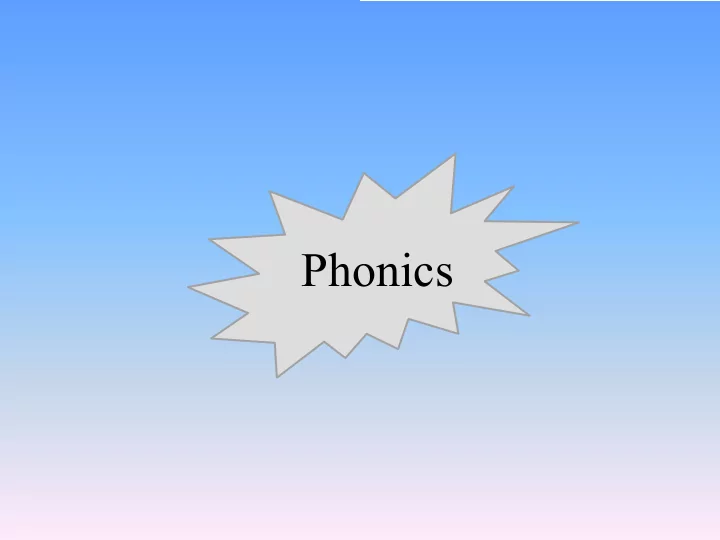

Phonics
Playing with sounds Skills: • Rhyme • Syllables e.g. clap them out in your name • Alliteration e.g. big bright butterfly • Swapping sounds e.g. rice (now take away the r), all (now add a w at the beginning) etc.
Phonics Phonics is taught as an adult led session each day. Some of the language you will hear your child using: - Phoneme – the smallest unit of sound that a word can be broken into (mat and sheep both have 3 phonemes) - Grapheme – how the sound is written ‘S’ - Digraph - two letters represent one phoneme ‘ch’ - Trigraph – three letters to represent one phoneme ‘igh’ - Blending – joining together of sounds in a word - Segmenting – splitting a word into distinct sounds - Tricky words - words that cannot be sounded out e.g. the, was, all
Phonics In phonics the two main skills we teach are: blending and segmenting Phonics applied to decodable words not tricky words eg: some/he/said Remember: To say pure sounds Video: http://www.youtube.com/watch?v=BqhXUW_ v-1s
Phonics • Phonic fingers…’how do I spell…..?’ • Each finger represents a sound • Activity time – dog = d o g – mat = -fighting – frog = - goats – scream = -played – light = -come Remember to join up at the end • Write: refer to sound mats • Root word then add ing/ed/s •
Phonics • Magnetic boards and multisensory learning • Multisensory learning: moving letters and saying sounds as child moves letters…again remember to blend sounds back to form word Activity time • Splash and princess…park, shark, dark and • shell, crab, sand, monster, claw
Phonics Activity time How many ways can you think of to make the sound ……?
Phonics and reading • Spot the sound….be a sound detective • Sound it out using finger buttons – dots and dashes examples Put it back together again (action: hands • pushing together) Long words break up: • sunbeam : s-u-n =sun and b-ea-m = beam – sunbeam
Other strategies to help remember sound/letter correspondence • Overlearning: slowly increasing sounds children are confident with and always revising known sounds • Passing sounds (with picture at back as a reminder)
Phonics: Song of Sounds • Stage 1: single sounds, digraphs and trigraphs (a, ee, igh) • Stage 2: Alternative spelling of sounds (ai, ay, a_e, eigh) • Stage 3: Support for spelling (prefixes, suffixes, spelling rules)
Phonics Test- Year 1 - Statutory test in Year 1. - Please don’t worry about it. - Mixture of real and alien words which cement the child's ability to blend diagraphs (share example).
Phonics in reading text • Only use phonics when word is not known • Encourage child to use context to help decode word in text…(s)he need to decode whole word eg it was snowing and Tom made a s-n-ow-m-a-n • If child is working too hard to decode text then comprehension and joy is lost
Guided Reading: Skills Read for meaning and enjoyment! Phonics is one of the skills children need when learning to read e.g. - Chunking words or finding smaller words: um-brell-as, sea-side. - If they find it difficult to say the sounds, say the word for them first, can they segment the word back to you? - Check that the word sounds like a real word. - Could it be a tricky (irregular) word e.g. some, all. - Character names! Other important reading skills: Read on and work out the missing word • Use of context to predict the word • Picture clues • Your child will probably use more than 1 of these skills to help them read. All valuable techniques when reading.
Guided Reading: Teaching How we support reading: • Daily! • Class split into groups depending on children’s book bands. • Each group works with the teacher once a week. • Focus: phonic application, comprehension, use of language, grammar. • Group activities.
Examples Phonic application - Where’s the ‘air’ trigraph used? - Can you spot the ‘ow’ sound? Comprehension - Why is the character feeling sad? - What do you think might happen if…? Use of language - What adjectives does the author use to describe….? - Why has the author used the word…? - What other word can you think of that means the same thing? Grammar - What ambitious verbs (doing words) can you spot? - How many questions can you find in the book?
Reading Response Sheets - How we use them in school. - A guideline for parents at home. - They are not a checklist of skills but more a point of reference for parents to generate ideas for questions. - Expanding your child’s reading and comprehension skills.
Reading at home It’s really important that children read daily: regular reading opportunities for a short time, ensures that reading stays enjoyable. Some tips: Don’t correct every mistake. • Try shared and repeated reading (particularly helpful when your child is tired). • Use the Reading Response Books to record daily reading. However, this book can • also be used for other learning opportunities e.g. maths. Use the suggested activities to help support your child’s reading and for prompts • on relevant comprehension questions to check their understanding of the book. We want each child to have a love of reading- therefore they need to be • exposed to a wide range of books and print. Don’t be surprised if your child comes home with the same book more than once, they choose their own books. Sometimes your child may choose a book that they didn’t like- this is okay if • they are able to explain why and perhaps comment in their reading response book to express their reason. It is all good learning!
Reading Response Book: Examples
Moving through the book bands It’s about loving reading and having a real understanding on what the story is about. It is not about speed!
Any questions?
Recommend
More recommend